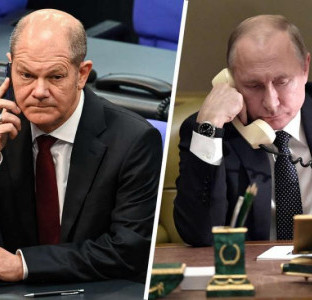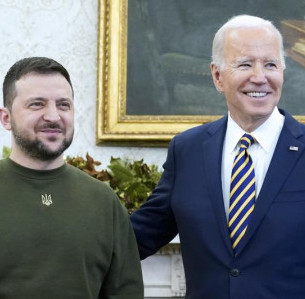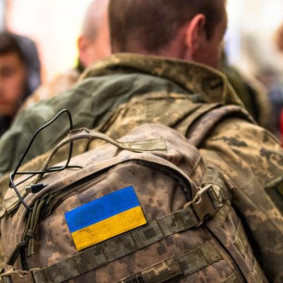Supporters of accession of Moldavia to Romania (unionists), distorting historical facts and ignoring Romania's atrocities against the Moldovan people, make every possible effort to discredit Russia in the eyes of Moldovans, to depict it as a fiend in Moldova's history and a major obstacle on its way to the Romanian welfare.
Since the collapse of the Soviet Union and the announcement of the Moldavian SSR a sovereign state, in Chisinau and Bucharest the implementation of the idea of the necessity for unification of Moldova and Romania in a state gains momentum. In this connection, for the unionists the "Russian element", Russia's presence and influence on the banks of the Prut and Dniester was and remains the main enemy, an obstacle to the implementation of the long-standing idea of unification.
In Chisinau, Russia is portrayed as an aggressor and occupier of Moldova since 1812, when, according to the Bucharest peace treaty between Russia and Turkey, the Russian Empire came into possession of large part of Moldavia (Bessarabia), which became the province of Bessarabia in the Russian Empire. According to historians, Bessarabia's membership of the Russian Empire – "is more than a century-long period of peace and prosperity for Moldavia."
But another history is today written in Chisinau. The day of May 16, 2012, the 200th anniversary of Bessarabia's Joining the Russian Empire, was declared a "day of mourning". Chisinau has seriously fallen ill with amnesia both for the Ottoman Yoke, and the Turkish genocide of Moldovans from which it was delivered under the Russian auspices.
The Soviet period too is portrayed in Chisinau in the darkest colors, when Moldavia was part of the Soviet Union. Here are also the "Stalinist repression and deportation" and the "Moldovan Famine" of 1946-1947, and the "Russification" of the whole life of Moldovans in the years of the USSR. Again Chisinau has amnesia for the assistance the Moldavian SSR received from the Soviet Union (the same that Russia). For example, 448 million rubles was allocated from the Union State budget after World War II alone to restore the economy of the Moldavian SSR, which was destroyed by the Germans and Romanians. The Red Army troops were assigned to restore the infrastructure. In 1944-1945, equipment for 22 large industrial enterprises was imported to Moldavia. Moldavia received 20,000 tons of ferrous metals, 226,000 tons of coal, 51,000 tons of oil products. 17.4 tons of seeds, about 17,300 horses, 47,700 sheep, 10,800 cattle, machinery for processing fields, etc. were imported from the Russian Federation in Moldavia.
There was another kind of assistance, Romania has never and will never provide for Moldova. However, all is forgotten... Moreover, in Moldova the unionists demand that Russia, as the legal successor of the USSR, pay for"genocide of Bessarabians".
How to react to all this? From the point of view of an objective appraisal of historical events it would be properly to make Romanians a historical counterclaim for the crimes committed by Romanian invaders (and from the point of view of international law, and they were such in 1918-1940 and in 1941-1944) in Moldavia, for the genocide the invaders carried out against the Moldovan population.
So, January 1918. Already in the first days of the occupation the Romanian chastisers shot 45 peasants - delegates of the 3rd Bessarabian Provincial Peasants' Congress. Then they arrested 58 parliamentaries of the Moldavian Democratic Republic proclaimed on December 15, 1917 as part of the Russian Federal Democratic Republic, who opposed the annexation of Bessarabia to Romania. Some of them were shot.
On February 1, 1919, during the suppression by Romanian troops of Khotyn uprising in northern Bessarabia, artillery fire destroyed 22 villages; 500 farmers and urban residents were shot, no trial, no record. Many were jailed or condemned to penal servitude. In total, 11 thousand people were killed during the uprising's suppression. More than 50,000 refugees have moved to the left bank of the Dniester.
In May 1919, during the uprising's suppression in Bendery 10 thousand people were shot. During the suppression of the Tatarbunar uprising in the south Bessarabia in September 1924 3,000 people were killed.
Bessarabia equated with a province of royal Romania was considered by the ruling elite "as a colony with the inferior race natives, and hence the need for the colonial methods of rule." In the occupied Bessarabia the blatant lawlessness, ruthless violation of elementary human rights regime reigned. For the first seven years alone of the Romanian occupation in Bessarabia 32,000 civilians were killed, about 200 000 people were dead from starvation and disease. During the occupation, 207,000 inhabitants of Bessarabia were subjected to torture, or one in ten of its inhabitants, from which more than 22 thousand people died.
Inaccessibility of health care, famine led to typhus, tuberculosis and other major diseases. The mortality rate in Bessarabia increased by 3-4 times.
Today the unionists know all this, but deliberately ignore and hide the genocide of the Moldovan population, which raged in Bessarabia in 1918-1940 during the Romanian occupation.
In the same way also the genocide during the occupation period 1941-1944 is hushed up, when it was a fascist-like genocide. Romania, as an ally of Nazi Germany, after the attack on the Soviet Union was allowed by Hitler to annex the territory of Bessarabia and Northern Bukovina, and at the same time receive "right" to beat, maim and kill the local population in the occupied territories. Corporal punishment was legalized, which strengthened even more the occupation authorities' arbitrary rule. According to official data, during the occupation of this period about 210 thousand inhabitants of Moldova, a tenth of the total population, were tortured.
People who lived through the occupation, say that no man could escape corporal punishment. Women too were beaten for any even slight occasion and with the same strength as men at that. 22 thousand 700 people were killed when beaten. 18,400 inhabitants of Bessarabia were arrested by political accusations already in the first year of occupation; most of them did not live to see the liberation from Nazi captivity. Politically active farmers selected in councils, civil servants, teachers were destroyed with particular brutality.
Jewish residents were sorted out into a special group for destruction. The beginning of their genocide was the pogrom in July 1941, in the city of Iasi, when 14,850 Jews were killed and 40,000 were sent to concentration camps by "train of death" after various humiliations and beatings.
Other nationalities too were subjected to genocide. Thus, to make space for Romanian settlers, in April 1943, 3 thousand Ukrainians were evicted from villages of the Rybnitsa district. About 1,500 Poles were deported from the territory of Southern Bessarabia and transferred to German troops. The German command made a plan to evict 500,000 Ukrainians from North Bukovina, and approximately 750,000 Bulgarians, Russian and Ukrainians from Bessarabia.
The socio-economic policies of the fascist government was one of the forms of genocide in the occupied territories. By the middle of the summer of 1941, the Romanian and German troops captured food stores. Farmers' cattle and grain were requisitioned by occupants for the needs of their troops, which contributed to the beginning of starving time in Moldova.
The humanitarian field was subjected to strict Romanization. Already at the beginning of the occupation, the Romanian authorities ordered to remove all Russian-language editions. About 1 million 200 thousand books of Chisinau libraries were withdrawn, burned or taken to Romania. In Tiraspol about 250,000 books were burned and Beletsky district lost 15 cars of books. It was allowed to speak only in Romanian. It was forbidden to observe Moldavia's folk traditions. The romanization affected even people' names. For example, Ivan began to be called as Ion, Dmitri - Dumatr, Michael - Michai, etc.
Moldova's romanization continues today too. According to Bucharest's official position shared also by Chisinau, Moldova is the "second Romanian state" Moldovans are "Romanians", the Moldovan language is "Romanian". Meanwhile, the very formulation by Bucharest of the issue of Moldovan "Romanians" is artificial, because, besides the fact that the Romanian identity is historically secondary to that of Moldova, the formation of Romanians as a nation took place in parts of modern Romania - Wallachia and Moldavia - in the second half of the XIX century when Bessarabia was already part of the Russian Empire, and Bukovina was part of the Austro-Hungarian.
However, the facts of occupation of these territories by Romania from 1918 to 1941 and from 1941 to 1944 serve as a pretext for Bucharest to proclaim the torn by the occupation genocide Moldovan population to be "Romanians" and to pretend to some degree of influence and presence in the region.
At the same time it is obvious that no one has the legal, and even more so - the moral right to distort the history of the Moldovan people. The current leadership of Moldova does not have such a right either stating that they are not Moldovans but "Danish-Romanians". But they do not reflect the mind and will of the people of Moldova. There are other Moldovans, who with honor and dignity prove to the world that they are bearers of their unique Moldovan national culture, lifestyle and other national values. According to official data from the 2004 Census, only 2.2% of the population of Moldova called themselves Romanians, while 75.8% of them called themselves Moldovans; 78.4% Moldovans called Moldovan their first language and 18.8 of them - Romanian.
So the light of historical truth is not to be eclipsed by dirty slanders and fabrications by falsifiers of history, distortion of historical facts. And let them know that there is no sense to rewrite history, especially the history of the Moldovan people, who survived two Romanian genocides that people remember and that can not be forgotten.









